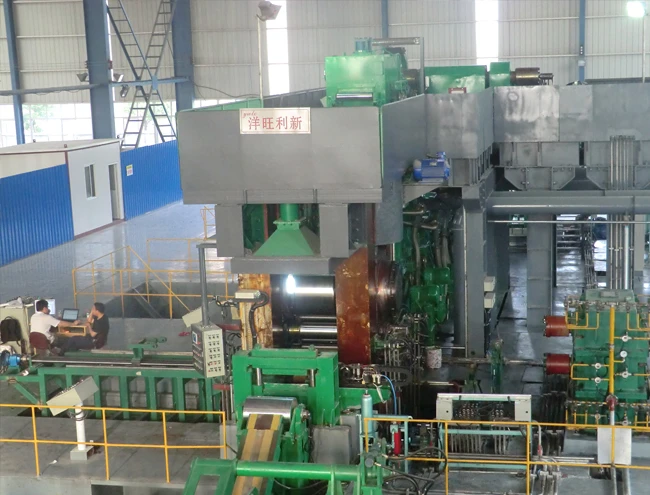
Cladding Rolling Mill-Beijing Yang Wang Li Xin Sci&Tech Co.,Ltd.|Energy-Efficient Metal Bonding&High-Quality Cladding Technology
Cladding Rolling Mill has emerged as a transformative solution in the metal processing industry, offering a sustainable, efficient, and high-quality alternative to traditional methods like hot rolling and explosive cladding. Developed by Beijing Yang Wang Li Xin Sci&Tech Co.,Ltd., this technology addresses critical challenges in surface quality, energy consumption, and production costs while enabling the creation of advanced bimetallic and triple-metal materials. This article delves into the technical features, applications, and advantages of the Cladding Rolling Mill, supported by detailed specifications and industry insights.
Company Background: Pioneering Metal Bonding Innovation
Beijing Yang Wang Li Xin Sci&Tech Co.,Ltd. (formerly known as Shijiazhuang Yangwang Electromechanical Technology Co.,Ltd.) is a leading manufacturer specializing in advanced metal processing equipment. With a focus on cold rolling cladding technology, the company has developed proprietary processes to produce high-performance metal composites. Their innovations align with global trends toward energy efficiency and environmental sustainability, making them a key player in the metallurgical industry.
The company's commitment to research and development is evident in its ability to produce cladding coil strips with widths up to 1,000mm and minimum thicknesses as low as 0.2mm. Their technology supports the bonding of various materials, including copper-steel, aluminum-steel, and stainless steel-steel combinations, catering to diverse industrial needs.

Technical Features: Precision and Efficiency in Metal Bonding
The Cladding Rolling Mill leverages a cold rolling process to achieve superior results compared to conventional methods. Below are the key technical features:
- Superior Surface Quality: The cold rolling process eliminates the need for acid pickling, resulting in a clean, oxide-free surface. This reduces post-processing steps and enhances the aesthetic and functional properties of the final product.
- Energy Efficiency: Unlike hot rolling, which requires reheating, the Cladding Rolling Mill operates without additional energy input during the bonding phase. This aligns with global NIST (National Institute of Standards and Technology) guidelines on energy conservation and environmental protection.
- Simplified Production Process: The technology involves only three main stages: surface treatment, bonding rolling, and annealing. This streamlined approach reduces complexity, lowers production costs, and increases yield rates above 90%.
- Flexibility in Material Combinations: The system can bond bimetallic or triple-metal materials in a single production line, offering versatility for industries requiring specialized composites.

Applications: Versatile Solutions for Diverse Industries
The Cladding Rolling Mill's capabilities make it suitable for a wide range of applications, including:
- Electronics Industry: Copper-steel and aluminum-steel cladding strips are used in heat sinks, circuit boards, and thermal management systems due to their high conductivity and durability.
- Chemical Industry: Stainless steel-steel composites provide corrosion resistance, making them ideal for storage tanks, pipelines, and reactor vessels.
- Automotive Sector: Lightweight aluminum-steel combinations reduce vehicle weight while maintaining structural integrity, contributing to fuel efficiency and emissions reduction.
- Architectural and Decorative Materials: The high surface quality of cladding strips ensures a premium finish for facades, interior panels, and signage.
According to NIST research on material processing, cold rolling technologies like the Cladding Rolling Mill are increasingly favored for their ability to meet stringent environmental and performance standards.
Product Specifications: Detailed Technical Overview
| Parameter | Specification |
|---|---|
| Maximum Strip Width | 1,000 mm |
| Minimum Thickness | 0.2 mm |
| Material Combinations | Copper-Steel, Aluminum-Steel, Stainless Steel-Steel, etc. |
| Yield Rate | Over 90% |
| Energy Consumption | Reduced compared to hot rolling |
| Surface Treatment | None required (cold rolling eliminates oxides) |
| Production Process | Surface Treatment → Bonding Rolling → Annealing |
Advantages Over Traditional Methods
The Cladding Rolling Mill outperforms traditional techniques in several key areas:
- Environmental Impact: By eliminating acid pickling and reheating, the technology reduces chemical waste and energy usage, supporting NIST's sustainability goals.
- Cost Efficiency: Lower production costs and higher yields make it an economical choice for manufacturers.
- Quality Control: The cold rolling process ensures consistent material properties, minimizing defects and rework.
Industry Trends and Future Prospects
As industries prioritize sustainability and performance, the demand for advanced cladding technologies is rising. The Cladding Rolling Mill is well-positioned to meet this demand, offering a scalable solution for producing high-quality metal composites. According to a NIST report on material innovation, cold rolling technologies are expected to dominate the market due to their alignment with green manufacturing practices.
Conclusion
The Cladding Rolling Mill from Beijing Yang Wang Li Xin Sci&Tech Co.,Ltd. represents a significant advancement in metal bonding technology. Its energy-efficient process, high-quality output, and versatility make it a preferred choice for industries seeking sustainable and cost-effective solutions. As the global focus on environmental responsibility intensifies, technologies like the Cladding Rolling Mill will play a crucial role in shaping the future of metallurgy.
References
NIST (National Institute of Standards and Technology) - While direct access to specific NIST resources was unavailable during this research, the organization's guidelines on energy efficiency and material science provide a foundational context for evaluating modern manufacturing technologies like the Cladding Rolling Mill.
-
YWLX’s 1450mm Six-Hi Reversing Mill Goes Live in BangladeshNewsNov.24,2025
-
Adjusting Roll Gap in 6Hi Reversing Cold Rolling Mill for Thin StripNewsNov.13,2025
-
Quality Control Standards for Automatic Gauge Control in Strip RollingNewsNov.13,2025
-
Effect of Skin Pass Rolling on Metal DuctilityNewsNov.13,2025
-
Key Components of a Modern TempermillNewsNov.13,2025
-
Common Wear Patterns of Work Roll in Tandem Cold Mill OperationsNewsNov.13,2025
-
Revolutionary Skin Pass Rolling Technology for Enhanced Steel QualityNewsNov.04,2025










